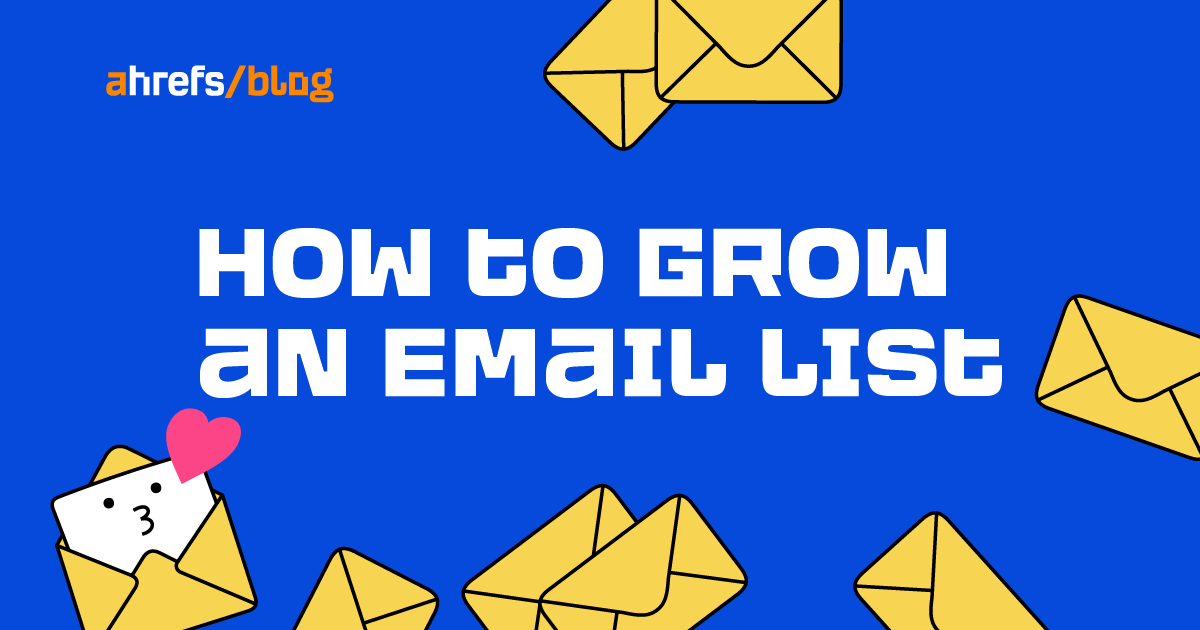SEO
8 Easy (But Effective) Ways to Grow Your Email List

Your email list is one of your business’s most important marketing assets. Rather than fleeting traffic from temporary social media posts or paid ads, these are people who have engaged with you and you have direct access to.
You can make money at the click of a button whenever you need to with a strong email list. Unlike other marketing channels, you have full control and ownership here.
So how do you grow your email list? We’ll go through the most effective tips and tactics I’ve learned by growing multiple email lists in the tens of thousands.
Before we dive into the action steps, let’s get your head straight. When it comes to growing an email list, you don’t just want as many raw numbers as possible.
Not only does this get expensive fast, it also hurts your email deliverability when you send content to lots of unengaged (and downright non-existent) email addresses.
Instead, you want to focus on growing a highly engaged email list. Quality AND quantity.
That means you should clean your list often, never buy generic lists, and always offer something of value to your newsletter subscribers. I’ll talk more about that last point later.
Now that I’ve got you thinking about quality leads, let’s talk about the tried and tested tactics for growing your email list.
1. Put your opt-ins in all the right places
Start with all your bases covered. Make sure you have email opt-ins in the usual places:
- On your homepage
- In your sidebar
- At the end of your blog content
These are obvious places, but they can be overlooked—we want to start with a strong baseline before we get into the more advanced tactics.
Something like this works well:

What should you say in your opt-in?
While you can have a general “Join 7,000+ brilliant minds like yourself,” it’s better to have something more targeted to your audience’s desires.
Unless your content is something special to your readers (which, let’s be honest, it better be if you want to grow an online business), no one is going to sign up for another generic email spam list.
2. Attract high-quality website traffic
The quality of your email list starts with the quality of your website traffic. No matter how well your opt-ins convert, it won’t matter if the right people aren’t visiting your website.
That’s where SEO and content marketing come in. Great content targeting relevant keywords can attract quality traffic on autopilot from search engines like Google.
SEO has a learning curve and takes time to work, but it’s one of the most effective forms of content marketing to grow your email list.
It starts with keyword research—knowing what keywords your ideal customers are searching for and how to rank for those keywords.
You can do this quickly with a competitor content gap analysis. Simply type your website into Ahrefs’ Site Explorer and click the Content gap button at the bottom of the left-hand menu here.

Then, plug in three or more of your competitors. If you don’t know who your competitors are, you can find them with the Competing Domains report right above the Content Gap report.

Once you hit Show keywords, you’ll get a list of all the keywords your competitors rank for, but you don’t. That can sometimes be tens of thousands of keywords, so you’re better off starting with keywords that all the competitors rank for to get the most relevant results:

From here, you’ll have a solid list of ideas for what you need to create content for.
Want to learn more? Start with these SEO guides:
3. Create content upgrades
A content upgrade is exactly what it sounds like—an “upgrade” to the content you’re currently reading.
A few examples of this can be:
- An “ultimate guide” to burning fat on an article about exercises to lose weight.
- A budgeting spreadsheet on an article about how to create a budget.
- A video series about how to play the ukulele on an article about the best ukuleles for beginners.
You can get as creative as you want with this. What’s something you can give your readers that will be really valuable to them and relevant to what they’re currently reading?
For example, I’ve got thousands of emails by creating a spreadsheet comparing over 50 different small campers as a content upgrade on my guide to the best small campers.
Here’s what the opt-in form looks like:

And here’s a look at the spreadsheet they get when they sign up:

My readers were more likely to subscribe to my list because they got something relevant that was really useful during their research to figure out which camper to buy.
Ready to do this yourself?
To figure out which pages you should create upgrades for, take a look at your highest-trafficked pages in Google Analytics. Just go to “Pages and screens” in GA4 (or Behavior > All Content > Landing Pages in the old GA), and it automatically sorts by number of views.

Then create content upgrades that make sense for your highest-trafficked pages.
Try to think of upgrades you can use across multiple pages to save on time and costs. For example, an ultimate guide to weight loss can be promoted across articles about best foods for weight loss, best exercises for weight loss, etc.
Again, search engine optimization is going to be your best friend with this tactic. If you combine content upgrades with posts that are ranking on Google, you’ll grow your email list on autopilot.
4. Host giveaways
Let me start with a giant disclaimer: Generic giveaways are a great way to grow an email list… full of fake or unengaged emails.
Many people create emails (that they never actually check or use) for the sole purpose of signing up for giveaways. Or they sign up and then immediately unsubscribe after the giveaway is over.
Instead of giving away something generic, such as cash or some fancy electronics, stick with giving away something directly related to your target market.
For example, if you’re in the fitness space, give away fitness equipment. If you’re in the woodworking space, give away woodworking equipment. You get the idea.
Better yet, if you sell products of your own, give away your own products. That way, even if someone leaves your email list, you’re still at least on their mind whenever they use your stuff.
One example of a well-done giveaway is this one by iKamper:

Here’s what makes it good:
- It’s giving away its own products.
- It partnered with other big brands in the outdoor camping space.
- All of the products in the giveaway are relevant to iKamper’s customers (no generic products or cash).
In other words, only people who may be potential iKamper customers are actually signing up for the giveaway.
Plus, by partnering with other brands, it’s increasing its reach while also building relationships with powerful partners.
If you’re going to do a giveaway, make sure you do it legally. Notice how it says in the post that Instagram isn’t endorsing its giveaway. This is just one of the things you need to do to legally hold a giveaway. These rules differ from country to country.
5. Use exit-intent pop-ups
Pop-ups are annoying, right?
Of course—if it’s something you don’t care about.
That’s why you should only use exit-intent pop-ups with, well, intention. Don’t just spam your readers with “Hey! Sign up for my list!” without offering them something they care about.
Instead, only use exit-intent pop-ups to give your readers something they really want. A discount code can work, although that doesn’t guarantee customer retention.
The approach I’ve found to work the best is to combine these pop-ups with the content upgrades we went through in tactic #3. It makes your upgrade obvious and lowers your chances of the pop-up being really annoying.
Speaking of being less annoying… here are some other tips to avoid aggravating your readers:
- Make sure your pop-up is easy and obvious to close out. Make the “X” in the corner easy to see and ensure the pop-up closes if they click outside the box.
- Only display the pop-up after a certain amount of time on a page or after a certain scroll depth so it doesn’t display right away and make people immediately leave. You should be able to set these conditions in the pop-up settings of most tools.
That way, you maximize the benefits of the pop-up and minimize the annoyance.
Here’s a great example of an exit-intent pop-up:

It’s good because:
- It’s easy to close. (There’s a visible “X” and a “No, thanks” option.)
- It’s offering something of value, not just asking you to subscribe.
- It’s highly relevant for Tim Ferriss’ audience (he talks a lot about how to improve your life).
There are many tools and plugins you can use to create the pop-up and manage your subscribers. I personally use ConvertKit to manage my list and Thrive Lightboxes to make my pop-ups, but use whatever you prefer.
6. Never spam your list
OK, this is an obvious tip. But it can’t be overstated to not exhaust your list with useless emails. This boils down to:
- Not sending something your list won’t care about.
- Only sending two to four emails per month unless your emails are about something time-sensitive that people obviously want more frequent updates on (like news or market updates).
Subscriber retention also hugely contributes to sustainable growth. That’s it—on to #7.
7. Utilize a drip feed
The last thing you want to do is let your hard-earned email list go cold. It can be easy to forget to send consistently—besides, not everyone on your list is at the same stage of your marketing funnel.
That’s where a drip feed comes in. This is a series of emails you set up ahead of time to “drip” out to your list over time. It’s basically a way to ensure you’re sending to your list consistently without needing to write a new broadcast email every week.
For example, your drip campaign can look like this:
- A reader subscribes to your list to get their ultimate guide to weight loss.
- Your email marketing software sends them a welcome email along with their PDF.
- The next day, your new subscriber gets “dripped” another email with a video version of their guide that also promotes your products.
- A week later, they get a check-in email asking how they’re doing with their goals.
- Etc.
These “dripped out” emails can promote your older content, share your new content, give tips and best practices, and occasionally promote relevant products to your list.
Plus, they give you the added benefit of only needing to schedule the emails once, then let the automation handle things for you from there.
Speaking of automation…
8. Segment your list
Would you want to get an email about weight loss tips if you’re trying to bulk up? Probably not. That’s why if you offer content on different topics within a niche, it’s best to segment your list so your readers only get the emails that are most relevant to what they care about.
There are several ways you can segment your list:
- Segment based on which content upgrade they signed up for (i.e., weight loss guide gets into the weight loss segment, muscle building guide gets into the muscle building segment).
- Simply ask your subscribers their preferences in the welcome email. Give them a bulleted list of topics that are hyperlinked with different tags for different segments. For example, you could make a list like this:
- I’m interested in losing weight.
- I’m interested in building muscle.
- I’m interested in having more energy and being generally healthier.
- Segment based on which product(s) the subscriber purchased.
Each email automation software is different in how it handles these types of automations and tags. But for ConvertKit (the one that I use), here’s how to do this:
Click the Automate dropdown, then Rules.

Click + New Rule in the top right, and you’ll be prompted to choose a Trigger and an Action. Depending on which segmentation strategy you want to use from the three I mentioned above, you’ll need to do a different trigger.
For this example, I’ll keep it simple—click Subscribes to a form as a trigger and Subscribe to a sequence as an action. (Note that you’ll need to set up the form and sequence before this for it to work.) This makes it so whenever someone subscribes via the form you chose, they will be added to the sequence (the “drip feed”) you selected.
Additionally, click the + under the Subscribe to a sequence action and add the second action Add tag with the corresponding segment tag for that particular form. This will add a tag to anyone who subscribes to that form, thus allowing you to “segment” them.

When you’re happy with the settings, click Save Rule. That’s all you have to do.
Final thoughts
Again, your email list is arguably one of your business’s biggest assets. It’s a customer list that you have control of—unlike other marketing channels.
The tactics I’ve outlined above have helped me build several lists in the tens of thousands, with people who stay engaged and care when I send out an email.
Treat your list like gold, never take advantage of it, and remember that there are real people at the other end of those emails. That’s the way to grow and keep a high-quality email list.
SEO
Google Cautions On Blocking GoogleOther Bot

Google’s Gary Illyes answered a question about the non-search features that the GoogleOther crawler supports, then added a caution about the consequences of blocking GoogleOther.
What Is GoogleOther?
GoogleOther is a generic crawler created by Google for the various purposes that fall outside of those of bots that specialize for Search, Ads, Video, Images, News, Desktop and Mobile. It can be used by internal teams at Google for research and development in relation to various products.
The official description of GoogleOther is:
“GoogleOther is the generic crawler that may be used by various product teams for fetching publicly accessible content from sites. For example, it may be used for one-off crawls for internal research and development.”
Something that may be surprising is that there are actually three kinds of GoogleOther crawlers.
Three Kinds Of GoogleOther Crawlers
- GoogleOther
Generic crawler for public URLs - GoogleOther-Image
Optimized to crawl public image URLs - GoogleOther-Video
Optimized to crawl public video URLs
All three GoogleOther crawlers can be used for research and development purposes. That’s just one purpose that Google publicly acknowledges that all three versions of GoogleOther could be used for.
What Non-Search Features Does GoogleOther Support?
Google doesn’t say what specific non-search features GoogleOther supports, probably because it doesn’t really “support” a specific feature. It exists for research and development crawling which could be in support of a new product or an improvement in a current product, it’s a highly open and generic purpose.
This is the question asked that Gary narrated:
“What non-search features does GoogleOther crawling support?”
Gary Illyes answered:
“This is a very topical question, and I think it is a very good question. Besides what’s in the public I don’t have more to share.
GoogleOther is the generic crawler that may be used by various product teams for fetching publicly accessible content from sites. For example, it may be used for one-off crawls for internal research and development.
Historically Googlebot was used for this, but that kind of makes things murky and less transparent, so we launched GoogleOther so you have better controls over what your site is crawled for.
That said GoogleOther is not tied to a single product, so opting out of GoogleOther crawling might affect a wide range of things across the Google universe; alas, not Search, search is only Googlebot.”
It Might Affect A Wide Range Of Things
Gary is clear that blocking GoogleOther wouldn’t have an affect on Google Search because Googlebot is the crawler used for indexing content. So if blocking any of the three versions of GoogleOther is something a site owner wants to do, then it should be okay to do that without a negative effect on search rankings.
But Gary also cautioned about the outcome that blocking GoogleOther, saying that it would have an effect on other products and services across Google. He didn’t state which other products it could affect nor did he elaborate on the pros or cons of blocking GoogleOther.
Pros And Cons Of Blocking GoogleOther
Whether or not to block GoogleOther doesn’t necessarily have a straightforward answer. There are several considerations to whether doing that makes sense.
Pros
Inclusion in research for a future Google product that’s related to search (maps, shopping, images, a new feature in search) could be useful. It might be helpful to have a site included in that kind of research because it might be used for testing something good for a site and be one of the few sites chosen to test a feature that could increase earnings for a site.
Another consideration is that blocking GoogleOther to save on server resources is not necessarily a valid reason because GoogleOther doesn’t seem to crawl so often that it makes a noticeable impact.
If blocking Google from using site content for AI is a concern then blocking GoogleOther will have no impact on that at all. GoogleOther has nothing to do with crawling for Google Gemini apps or Vertex AI, including any future products that will be used for training associated language models. The bot for that specific use case is Google-Extended.
Cons
On the other hand it might not be helpful to allow GoogleOther if it’s being used to test something related to fighting spam and there’s something the site has to hide.
It’s possible that a site owner might not want to participate if GoogleOther comes crawling for market research or for training machine learning models (for internal purposes) that are unrelated to public-facing products like Gemini and Vertex.
Allowing GoogleOther to crawl a site for unknown purposes is like giving Google a blank check to use your site data in any way they see fit outside of training public-facing LLMs or purposes related to named bots like GoogleBot.
Takeaway
Should you block GoogleOther? It’s a coin toss. There are possible potential benefits but in general there isn’t enough information to make an informed decision.
Listen to the Google SEO Office Hours podcast at the 1:30 minute mark:
Featured Image by Shutterstock/Cast Of Thousands
SEO
AI Search Boosts User Satisfaction

A new study finds that despite concerns about AI in online services, users are more satisfied with search engines and social media platforms than before.
The American Customer Satisfaction Index (ACSI) conducted its annual survey of search and social media users, finding that satisfaction has either held steady or improved.
This comes at a time when major tech companies are heavily investing in AI to enhance their services.
Search Engine Satisfaction Holds Strong
Google, Bing, and other search engines have rapidly integrated AI features into their platforms over the past year. While critics have raised concerns about potential negative impacts, the ACSI study suggests users are responding positively.
Google maintains its position as the most satisfying search engine with an ACSI score of 81, up 1% from last year. Users particularly appreciate its AI-powered features.
Interestingly, Bing and Yahoo! have seen notable improvements in user satisfaction, notching 3% gains to reach scores of 77 and 76, respectively. These are their highest ACSI scores in over a decade, likely due to their AI enhancements launched in 2023.
The study hints at the potential of new AI-enabled search functionality to drive further improvements in the customer experience. Bing has seen its market share improve by small but notable margins, rising from 6.35% in the first quarter of 2023 to 7.87% in Q1 2024.
Customer Experience Improvements
The ACSI study shows improvements across nearly all benchmarks of the customer experience for search engines. Notable areas of improvement include:
- Ease of navigation
- Ease of using the site on different devices
- Loading speed performance and reliability
- Variety of services and information
- Freshness of content
These improvements suggest that AI enhancements positively impact various aspects of the search experience.
Social Media Sees Modest Gains
For the third year in a row, user satisfaction with social media platforms is on the rise, increasing 1% to an ACSI score of 74.
TikTok has emerged as the new industry leader among major sites, edging past YouTube with a score of 78. This underscores the platform’s effective use of AI-driven content recommendations.
Meta’s Facebook and Instagram have also seen significant improvements in user satisfaction, showing 3-point gains. While Facebook remains near the bottom of the industry at 69, Instagram’s score of 76 puts it within striking distance of the leaders.
Challenges Remain
Despite improvements, the study highlights ongoing privacy and advertising challenges for search engines and social media platforms. Privacy ratings for search engines remain relatively low but steady at 79, while social media platforms score even lower at 73.
Advertising experiences emerge as a key differentiator between higher- and lower-satisfaction brands, particularly in social media. New ACSI benchmarks reveal user concerns about advertising content’s trustworthiness and personal relevance.
Why This Matters For SEO Professionals
This study provides an independent perspective on how users are responding to the AI push in online services. For SEO professionals, these findings suggest that:
- AI-enhanced search features resonate with users, potentially changing search behavior and expectations.
- The improving satisfaction with alternative search engines like Bing may lead to a more diverse search landscape.
- The continued importance of factors like content freshness and site performance in user satisfaction aligns with long-standing SEO best practices.
As AI becomes more integrated into our online experiences, SEO strategies may need to adapt to changing user preferences.
Featured Image: kate3155/Shutterstock
SEO
Google To Upgrade All Retailers To New Merchant Center By September

Google has announced plans to transition all retailers to its updated Merchant Center platform by September.
This move will affect e-commerce businesses globally and comes ahead of the holiday shopping season.
The Merchant Center is a tool for online retailers to manage how their products appear across Google’s shopping services.
Key Changes & Features
The new Merchant Center includes several significant updates.
Product Studio
An AI-powered tool for content creation. Google reports that 80% of current users view it as improving efficiency.
This feature allows retailers to generate tailored product assets, animate still images, and modify existing product images to match brand aesthetics.
It also simplifies tasks like background removal and image resolution enhancement.
Centralized Analytics
A new tab consolidating various business insights, including pricing data and competitive analysis tools.
Retailers can access pricing recommendations, competitive visibility reports, and retail-specific search trends, enabling them to make data-driven decisions and capitalize on popular product categories.
Redesigned Navigation
Google claims the new interface is more intuitive and cites increased setup success rates for new merchants.
The platform now offers simplified website verification processes and can pre-populate product information during setup.
Initial User Response
According to Google, early adopters have shown increased engagement with the platform.
The company reports a 25% increase in omnichannel merchants adding product offers in the new system. However, these figures have yet to be independently verified.
Jeff Harrell, Google’s Senior Director of Merchant Shopping, states in an announcement:
“We’ve seen a significant increase in retention and engagement among existing online merchants who have moved to the new Merchant Center.”
Potential Challenges and Support
While Google emphasizes the upgrade’s benefits, some retailers, particularly those comfortable with the current version, may face challenges adapting to the new system.
The upgrade’s mandatory nature could raise concerns among users who prefer the existing interface or have integrated workflows based on the current system.
To address these concerns, Google has stated that it will provide resources and support to help with the transition. This includes tutorial videos, detailed documentation, and access to customer support teams for troubleshooting.
Industry Context
This update comes as e-commerce platforms evolve, with major players like Amazon and Shopify enhancing their seller tools. Google’s move is part of broader efforts to maintain competitiveness in the e-commerce services sector.
The upgrade could impact consumers by improving product listings and providing more accurate information across Google’s shopping services.
For the e-commerce industry as a whole, it signals a continued push towards AI-driven tools and data-centric decision-making.
Transition Timeline
Google states that retailers will be automatically upgraded by September if they still need to transition.
The company advises users to familiarize themselves with the new features before the busy holiday shopping period.
Featured Image: BestForBest/Shutterstock
-

 SEARCHENGINES6 days ago
SEARCHENGINES6 days agoBillions Of Google goo.gl URLs To 404 In The Future
-
SEARCHENGINES5 days ago
Daily Search Forum Recap: July 22, 2024
-

 SEARCHENGINES7 days ago
SEARCHENGINES7 days agoGoogle Core Update Coming, Ranking Volatility, Bye Search Notes, AI Overviews, Ads & More
-

 SEO6 days ago
SEO6 days ago11 Copyscape Alternatives To Check Plagiarism
-

 SEO6 days ago
SEO6 days agoGoogle Warns Of Last Chance To Export Notes Search Data
-
SEARCHENGINES4 days ago
Daily Search Forum Recap: July 23, 2024
-

 AFFILIATE MARKETING6 days ago
AFFILIATE MARKETING6 days agoThe Top 5 AI Tools That Can Revolutionize Your Workflow and Boost Productivity
-

 SEO4 days ago
SEO4 days agoSystem Builders – How AI Changes The Work Of SEO
















You must be logged in to post a comment Login